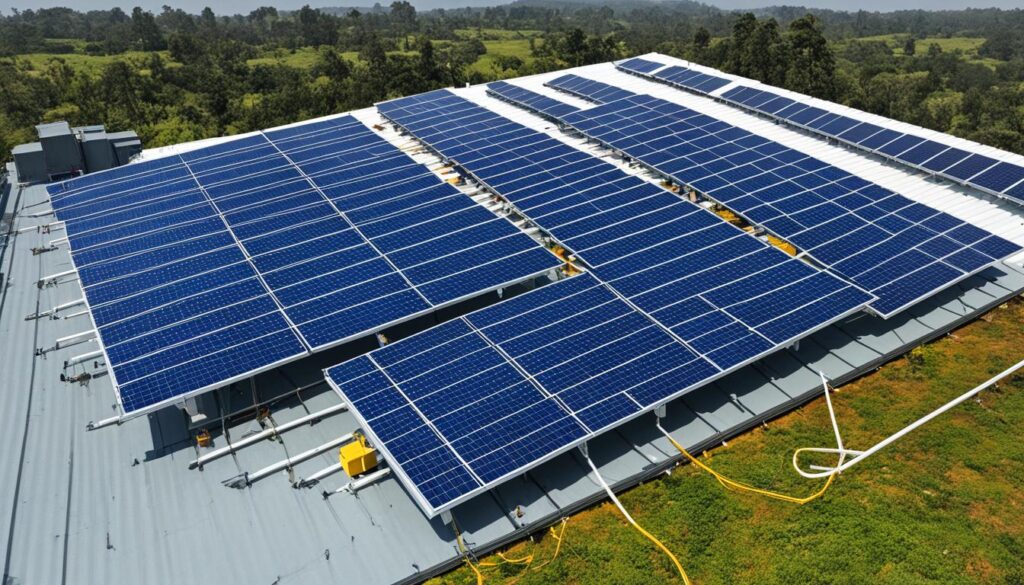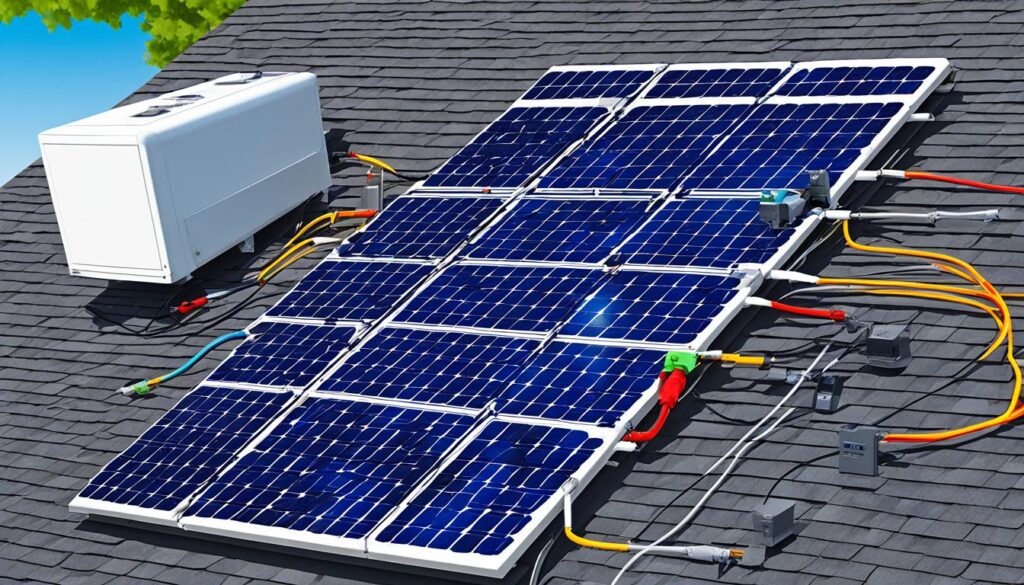When it comes to harnessing renewable energy, solar power stands out as a reliable and sustainable option. Solar energy production encompasses various systems, including photovoltaic solar, solar hot water, and concentrated solar power. Each system operates differently and requires specific setups to maximize energy generation.
Photovoltaic solar systems, often referred to as solar panel systems, directly convert sunlight into electricity using solar panels. These panels consist of multiple interconnected solar cells that absorb photons from the sun and generate an electrical current. Understanding the components and layout of a solar panel system is crucial for effective energy production.
Solar hot water systems, on the other hand, utilize solar collectors to harness the sun’s heat and warm water. These systems rely on a closed-loop circulation system, allowing the transfer of thermal energy from the collectors to a storage tank. By comprehending the setup and flow chart of a solar hot water system, it becomes easier to harness solar energy for heating purposes.
Concentrated solar power systems, commonly known as CSP, concentrate sunlight using lenses or mirrors onto a small area. This intense heat is then used to create steam that drives a turbine and produces electricity. The diagram and setup of a CSP system play a significant role in ensuring efficient energy conversion.
Key Takeaways:
- Understanding the basics of solar energy production involves exploring different systems such as photovoltaic solar, solar hot water, and concentrated solar power.
- Solar panel diagrams demonstrate the components and layout of a photovoltaic solar system, enabling successful electricity generation.
- Solar hot water systems utilize solar collectors and a closed-loop circulation system to harness solar energy for heating purposes.
- Concentrated solar power systems focus sunlight onto a small area to generate steam and produce electricity through the use of turbines.
- Gaining knowledge about the setups and flow charts of these solar energy systems is essential for optimizing energy production.
Solar Energy Diagram: Insolation and Solar Power (PV)
Insolation is the term used to describe the amount of solar energy that reaches the Earth’s surface. It refers to the solar radiation that directly hits the Earth. This energy is more abundant than all the fossil fuels combined, making it a valuable resource for sustainable power generation.
Solar power, also known as photovoltaic solar (solar PV), harnesses the energy from the sun to produce electricity. The process involves converting sunlight into usable electrical energy through the use of photovoltaic solar panels. These panels contain semiconductor materials that generate an electric current when exposed to sunlight.
Photovoltaic solar panels work by utilizing the photovoltaic effect, where sunlight excites the electrons in the panel’s semiconductor material, creating a flow of electricity. This electricity can then be used to power various devices or stored in batteries for later use.
In addition to photovoltaic solar panels, solar power can also be generated through concentrated solar power (CSP) systems. These systems use lenses or mirrors to concentrate sunlight onto a small area, typically a receiver or a solar power tower. The concentrated sunlight heats a working fluid, such as water or oil, to create steam, which then drives a turbine to produce electricity.
Both photovoltaic solar and concentrated solar power systems play a crucial role in harnessing solar energy and providing a sustainable source of power. By converting solar energy into electricity, they help reduce our dependence on non-renewable energy sources and contribute to a cleaner and greener future.

Advantages of Solar Power
- Renewable and abundant source of energy
- Reduces greenhouse gas emissions
- Reduces reliance on fossil fuels
- Low operating costs and maintenance
- Long lifespan of solar panels
“Solar power is a game-changer in the field of renewable energy. It offers a sustainable solution to meet our energy needs while minimizing the impact on the environment.” – Sarah Green
Solar Energy Diagram: Passive Solar Design, Solar Hot Water, and Concentrated Solar Power
**
Passive solar design is an innovative approach that harnesses the power of sunlight to convert it into usable heat. This energy-efficient technique utilizes structural elements and design features to maximize solar gain during winter and minimize excessive sun exposure during summer. One popular feature of passive solar design is the use of roof slopes to optimize sunlight absorption while ensuring proper insulation. By utilizing natural resources such as sunlight, passive solar design offers sustainable heating solutions for homes and buildings.
Solar hot water systems are another way to utilize solar energy effectively. These systems use solar collectors to heat water through a closed-loop process. The solar collectors absorb sunlight and transfer the heat to water, providing a cost-effective and eco-friendly alternative to traditional water heating methods. Solar hot water systems are widely adopted in residential and commercial properties as they not only reduce energy consumption but also contribute to a greener environment.
Concentrated solar power (CSP) takes solar energy utilization a step further by employing advanced technologies to generate electricity. CSP systems focus sunlight onto a small area using mirrors or lenses. The concentrated sunlight heats a working fluid, usually water or oil, which produces steam to drive a turbine and generate electricity. This highly efficient method allows for large-scale power generation and offers a sustainable solution to meet the increasing energy demands of the future.
Each of these solar energy systems has its unique diagrams and setups, illustrating the different mechanisms through which they harness the power of the sun. From passive solar design optimizing natural sunlight to solar hot water systems utilizing solar collectors for water heating and concentrated solar power systems generating electricity through reflected sunlight, these technologies play a vital role in the transition towards a cleaner and more sustainable future.
FAQ
What is a solar energy diagram and why is it important?
A solar energy diagram is a visual representation of the setup and components involved in solar energy production systems. It provides a clear understanding of how solar energy is collected, converted, and used. A diagram helps in planning and designing solar energy systems, ensuring efficient energy production and utilization.
What does a solar system diagram entail?
A solar system diagram illustrates the various components of a solar energy system, including solar panels, inverters, batteries (if applicable), and the connection to the electrical grid. It shows how these components work together to convert sunlight into usable electricity or heat.
Can you explain the solar energy flow chart?
The solar energy flow chart illustrates the process of converting sunlight into electricity using photovoltaic solar panels. It shows how sunlight is absorbed by the panels, exciting electrons and creating an electric current. The flow chart also includes the conversion of the direct current (DC) generated by the panels into alternating current (AC) for use in homes and businesses.
What is the purpose of a solar power diagram?
A solar power diagram provides an overview of how solar energy is harnessed and utilized. It showcases different types of solar power systems, such as photovoltaic solar panels and concentrated solar power. The diagram demonstrates the process of converting sunlight into electricity or heat, highlighting the role of specific components and technologies involved.
How does a solar energy process work?
The solar energy process involves the capture, conversion, and utilization of sunlight as a renewable energy source. Photovoltaic solar panels convert sunlight into electricity, while solar hot water systems use solar collectors to heat water. Concentrated solar power systems use mirrors or lenses to focus sunlight onto a small area, creating steam that drives a turbine for electricity generation.
What is a single-line diagram for a solar energy system?
A single-line diagram for a solar energy system is a simplified representation of the electrical connections and equipment used in the system. It shows the flow of electricity from the solar panels to the inverter and other components, highlighting the interconnections and protection devices used.

